
Imagine an Uber with professional drivers, easily identifiable cars and no surge pricing.
Oh, wait – that’s a taxi company.
Now, a partnership between Curb and Via is letting New Yorkers treat taxis just like Uber pools. Not only can they call a cab with their mobile device, book a ride in advance or pay in-app for a street-hailed ride – they can share any of those rides with other riders along the route and enjoy a 40 percent discount on the shared portion of the ride.
“It’s part of a strategy we’ve been taking to market to help keep taxis competitive and provide our company with more earning power,” said Jason Gross, global head of product and marketing for Verifone, which powers Curb.
“We’ve really tried to make taxis competitive with consumer expectations,” Gross said. “We’re really competing for their attention by providing them more worth.”
Curb already works with a variety of New York taxi companies, including thousands of individual driver-owners and drivers who rent cabs from a fleet or management company, to integrate with whatever device is already in the vehicle.
13,000 of New York’s iconic yellow cabs use Curb’s Dash platform to receive jobs and accept mobile and plastic payments. Users have a taxi assigned to them within 30 seconds and wait no more than five minutes for it to arrive. It’s America’s No. 1 taxi app.
Verifone also pioneered the “pay and pair” technology that allows riders to simply climb into a cab and pair their phone with the car to pay, no card-swiping or phone-tapping required.
Meanwhile, Via is the No. 1 on-demand ride sharing app in the world. It deploys a smart algorithm to direct passengers to a nearby intersection for pickup and drop-off, making shared rides more efficient by avoiding long detours (and those pain-in-the-neck left turns that back up traffic on busy streets!).
Via automatically splits up the fare based on how long each passenger was in the vehicle and how much of the ride was shared.
Together, Curb and Via are making sharing rides even faster and easier, especially at peak times such as rush hour and shift change when there often aren’t enough cabs to go around. Now, drivers can move more passengers quickly, freeing them up to serve additional riders and even reducing the number of cars that need to be on the road.
“New York City has a large fleet of 13,000-plus yellow taxis, but there’s very little sharing going on between passengers,” Gross said. “This is an opportunity to make it more efficient as an industry.”
Plus, said Gross, “It’s a great benefit for drivers who have been playing by the rules.”
Taxi services are a regulated industry. They pay taxes and vet, train and license their drivers. And those drivers are working full-time to make an honest living. But in addition to losing business to ride-hailing apps like Uber and Lyft, professional taxi drivers can spend as much as 50 percent of their time driving around looking for passengers. That won’t be a problem anymore.
Drivers can now create what Gross called the “endless ride,” where they always pick up a new passenger before dropping off the first one to avoid ever having an empty cab. And Via technology can direct them straight to the next passenger whenever their back seat is empty.
Gross estimates that this could increase vehicle utilization by 10 to 20 percent just in the short term, and “hopefully more over time.”
Other big-picture benefits include reducing emissions and congestion by removing unnecessary vehicles from the road and better utilizing the ones that are there.
“At Via we’re committed to reducing congestion and emissions in major cities with a fully dynamic network of shared vehicles,” said Daniel Ramot, CEO and co-founder of Via.
“Everyone benefits when we increase the efficiency of vehicles on the road,” Ramot said. “Cities benefit from reduced congestion and emissions, riders benefit from affordable and convenient transportation options, and drivers benefit from a system optimized to increase their earnings.”
Via pitched the partnership a year and a half ago as the company looked to expand its footprint.
So far, the on-demand rideshare provider replaces or supplements public transit agencies in just three U.S. cities: New York, Chicago, and Washington, D.C. It also serves planned communities, college and corporate campuses, and vanpool and carpool scenarios.
Curb was interested right off the bat, since the company was already looking for ways to introduce and promote ride sharing.
But merging their visions turned out to be the easy part. Merging their technologies to give users the benefits of both apps – proved more challenging.
“Matching the tech on the back end is a real accomplishment for our shared teams,” Gross said. “It’s a complex ecosystem.”
Now that they’ve done it once, though, there’s definitely room for this partnership to grow. Curb hopes to roll out these services in all 65 of its markets over time. The app connects riders to more than 100,000 drivers in most major urban centers in the U.S., including Boston, Philadelphia and Las Vegas.
Gross said Curb is also looking for more ways to work with New York City’s Metropolitan Transportation Authority to serve paratransit customers. Currently, disabled riders have to book rides 24 hours in advance, and handicapped vans can often be seen driving around empty.
Curb has already worked with the MTA to alleviate some of these issues. By partnering with taxis for on-demand service, the MTA can save up to 50 percent over paying for vans that drive around without passengers in them. And taxi drivers and companies benefit as well.
“Those jobs didn’t go to taxis in the past,” Gross said. “There’s a real ecosystem behind this Curb platform that enables us to deliver all this demand that taxis weren’t able to participate in previously.”